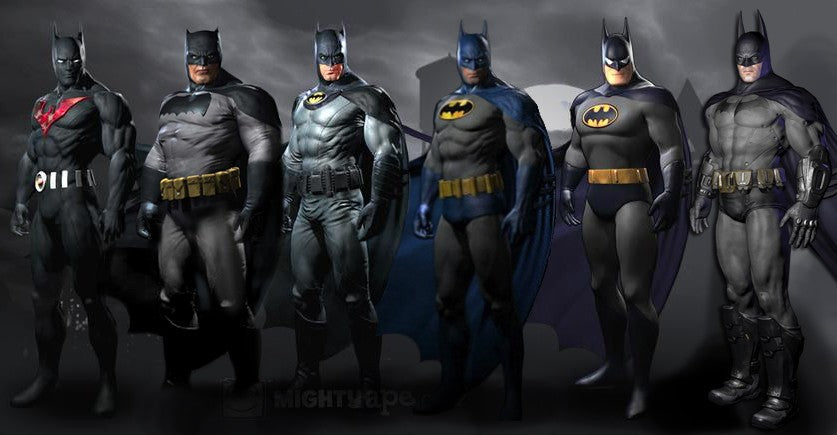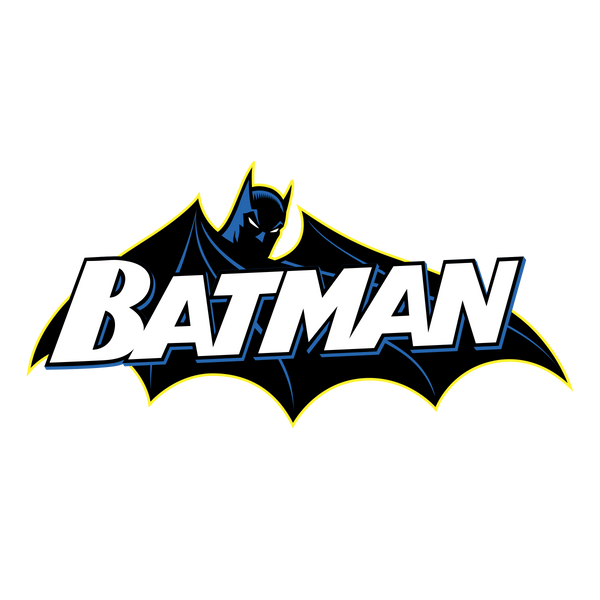
The Evolution of the Batman Costume Through the Decades: 1939 to Present Day
The Evolution of the Batman Costume Through the Decades: From 1939 to the Present
Before becoming a globally recognized symbol, the Batman costume was a modest creation, scribbled for the pages of Detective Comics #27 in 1939. Designed by Bob Kane and Bill Finger , this very first Batsuit already laid the visual foundations of the legend: flowing black cape, mask with pointed ears, gray jumpsuit and a rudimentary bat emblem on the torso.
With its simple lines and gothic atmosphere, this outfit evoked more of a nocturnal vigilante than a flamboyant superhero. The inspiration came from monster movies, the masked Zorro, and German Expressionist cinema. More than just a disguise, it embodied a psychological strategy: Bruce Wayne wanted to become the creature that criminals would fear at night .
The first adjustments (1940s – 1950s)
In the 1940s and 1950s, as comics grew in popularity and Batman was already facing some of his iconic foes , the costume underwent its first evolutions. The cape became longer and fuller, the utility belt gained visible compartments, and the mask adopted softer features. The bat emblem became more stylized and, in some versions, was surrounded by a yellow oval that would become iconic.
These changes are not just aesthetic: they reflect a desire to adapt Batman to an era marked by war , patriotism and the first adaptations into series and films . On paper, they make the hero more readable and recognizable, while strengthening his image among young audiences.
To relive this legendary era, explore our collection of Batman action figures inspired by the 40s to 60s, or embrace retro style with a vintage Dark Knight T-shirt .
The pop shift of the 60s
The 1960s marked a dramatic turning point with the cult TV series Batman (1966) , starring Adam West . Out went the dark shades, in came a blue-grey , a purple-tinged cape, tight shorts, and a bright canary-yellow belt . The character became a pop icon, punctuating his fights with the now-legendary "POW!" and "BAM!" speech bubbles.
This light and colorful Batman seduced an entire generation and flooded the market with posters , puzzles and costumes in flashy colors, contrasting with the dark iterations of previous decades.
While this pop look may have confused purists attached to the Dark Knight's dark roots, it nevertheless played a vital role in the widespread diffusion of the myth. For the first time, Batman was invited into family living rooms around the world and became a symbol of popular culture . Children donned their Batman costumes , hung colorful posters in their bedrooms, and discovered the hero through colorful toys and cartoons.
Return to the Shadows: The Tim Burton Era
It wasn't until the late 1980s that a darker wind blew through Gotham. In 1989 , Tim Burton delivered a Batman with a gothic, almost mythological aesthetic. With Michael Keaton under the mask, the costume was transformed: full-body molded rubber armor, a cape that spread like demonic wings, and a bright yellow emblem sitting in the center of the chest.
This design, both intimidating and charismatic, reinforced Batman's image as a nocturnal creature, a true predator of the shadows. It had a lasting influence on the 90s versions, including in the Joel Schumacher films, even if the latter took a more controversial direction with their nipple-covered costumes and fluorescent neon lights .
With the advent of the 2000s, the Batman costume entered the era of technological realism . Out went the rigid latex of previous versions, in came materials inspired by modern military and tactical equipment. This transformation began with Christopher Nolan 's trilogy, in which Christian Bale played a more human, vulnerable, but formidable strategist, Dark Knight.
- 2005 – Batman Begins: The Batsuit is introduced as a military prototype abandoned by Wayne Enterprises . Modular and made of Kevlar, it prioritizes mobility while providing ballistic protection. The black-on-black emblem reinforces its stealthy and menacing aspect.
- 2008 – The Dark Knight: First costume with a helmet separate from the armor, providing greater head mobility. The more angular design draws on real-world tactical ergonomics. Each element is designed for its function, reinforcing the universe's credibility.
- 2012 – The Dark Knight Rises: The armor is slightly modified to reflect the hero's wear, injuries, and experience, emphasizing the struggle against time and his physical limitations.
The Ben Affleck era: raw power and war armor
A few years later, Ben Affleck donned the costume in the DC Extended Universe. His version in Batman v Superman and Zack Snyder's Justice League is distinguished by a completely different approach:
- Massive Design: Inspired by Frank Miller 's comics, this Batman is a brute force. The reinforced textile armor and XXL symbol on the torso evoke a warrior more than a detective. This imposing look lends itself perfectly to premium throws and sweaters.
- Anti-Superman Armor: Designed to take on the Man of Steel, it adopts a full exoskeleton style, equipped with kryptonite, infrared vision and a voice amplifier. Equipment worthy of Gotham's greatest battles.
Robert Pattinson: Back to the Raw and Gothic
In 2022, Robert Pattinson took on the role in Matt Reeves' The Batman . This version features a more crafted and dark aesthetic:
- Handcrafted Costume: Hand-assembled, a blend of leather, metal, and ballistic fabric. The bat-shaped chest plate is said to be fashioned from the weapons that marked his past.
- Neo-noir style: More gothic and realistic, with a functional cape and military boots. This detective Batman, still at the beginning of his career, embodies a vigilante in the making.
From 1939 to the present day, the Batman costume has continually reinvented itself. Sometimes mysterious, sometimes ultra-technological, sometimes even theatrical, it reflects the eras, the artistic visions, and the inner struggles of Bruce Wayne. More than just an outfit, it's a declaration of war on crime, a suit of armor forged to inspire fear in enemies and reassure the innocent.
This ability to evolve while remaining true to its roots is what makes the Batsuit such an inseparable part of pop culture. From retro latex to realistic Kevlar plates, to The Batman 's gothic leather, each version embodies a different facet of the Dark Knight and his ethos.
Because one thing is certain: whether we're talking about Adam West's Batman, Michael Keaton's, Christian Bale's, Ben Affleck's or Robert Pattinson's, the costume is and will remain the vigilante's most visible weapon ... and the ultimate symbol of his crusade.
